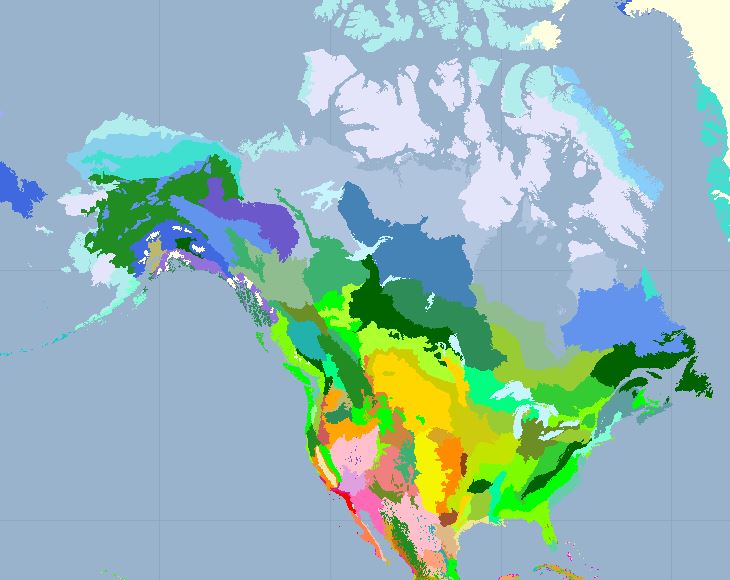Welcome to this site on ecoregion birding. It is also a blog where I write about various thoughts related to birding and ecoregions or more generally about conservation, and where I try to share my passion for the fascinating little stories of nature, and the links that bind everything together.
About Ecoregion Birding
The World Wildlife Fund (WWF) defines an ecoregion as “a relatively large area of land or water that contains a geographically distinct assemblage of natural communities. These communities (1) share a large majority of their species, dynamics, and environmental conditions, and (2) function together effectively as a conservation unit at global and continental scales” (Ricketts et al., 1999: Terrestrial Ecoregions of North America: a Conservation Assessment).
Ecoregion birding means keeping bird lists by ecoregion, a human-defined area, but one that is defined on the basis of natural characteristics. Almost all birders only keep list by county, state, province, or country, which are all units without much biological meaning or interest.
The ecoregion pages, accessible from the broad habitat groupings in the menu, cover all 109 terrestrial ecoregions of North America. Each page includes a map, very brief description, notes on the ecoregion’s avifauna, and a few resources for ecoregion birders. Note that many text elements are under construction (you are more than welcome to contribute!). A few ecoregions outside of North America can be found in a separate tab.
We follow here the ecoregions as defined by WWF. The WWF site includes detailed texts on each ecoregion (search for the name of the ecoregion or its code, that looks something like NA0806). Formerly, it was possible on the WWF site to consult maps of all the world’s ecoregions but very unfortunately, in 2018 WWF unexpectedly retired their Wildfinder site, and this is no longer possible.
Maps of the world’s ecoregions can still be found at a number of sites. One good source is Data Basin.
Characteristic Ecoregion Avifaunas
I am in the process of determining the “characteristic” bird species of each ecoregion in North America and will gradually add this information to the ecoregion descriptions. For an example, see the list for the Edwards Plateau Savannas. As an ecoregion birder, with biology on the brain, the intention is to focus more on the biologically significant species of regular occurrence, and to focus less on listing extremely rare or lost birds.
By “characteristic”, I mean a bird species that is to be found reliably and annually in the mix of habitats that define the ecoregion, and thus plays a biological role in its ecoregional dynamics. These are the species that a skilled and diligent birder could reasonably expect to find in an ecoregion, covering all of its typical habitats and assuming good coverage in all seasons. This is an admittedly subjective exercise, and there will be dissenting views on which species qualify – comments welcome! For bird ranges, I have relied heavily on the maps in David Sibley’s The Sibley Guide to Birds, Second Edition (2014).
Species are classed as residents (r), summer breeders (s), migrants (m), or occurring only in winter (w). When a species has a different status in different areas of the ecoregion (perhaps wintering in the north, resident in the south), the label is chosen that seems most representative of the species over the ecoregion as a whole.
Thus, for any given ecoregion, I exclude from the list of characteristic species those that, in my judgment:
- breed only on the transitional periphery and are better associated with the characteristic habitats of an adjacent ecoregion or are breeding only in a small disjunct patch out of their typical distribution range; in these cases, these species are noted on the list as peripheral (x) and do not count toward the ecoregion total of characteristic species;
- are rare migrants, typically not stopping in;
- occur in the ecoregion as rare (gray color) on Sibley’s maps (which he defines as a “single or up to a few records/year”);
- are Category 4 or 5 species on the ABA checklist, that is, Casual or Accidental;
- are pelagic species more typically seen at sea, even if occasionally to be seen from shore (if the species breeds in the ecoregion, I do include it).
The list or characteristic and peripheral species will be considerably less than the actual list of species that have been recorded in any ecoregion, as such a list will include many other rare, casual, and accidental species.
About me
Douglas J. Graham is a Canadian living in Kelowna, BC (formerly residing in Maryland, from 1992 to 2019). I am originally from Thunder Bay, ON (Western Great Lakes Forests Ecoregion), and am a biologist (formerly an Environmental Specialist at the World Bank in Washington, DC). My spouse is France Marcoux from Québec City, QC (Eastern Great Lakes Lowland Forests Ecoregion), a keen photographer with a great appreciation of nature and traveling.
I can be reached at douglasjgraham@me.com.
Here are some of my most recent observations from my latest passion: iNaturalist.


Amazing wonderful. Your lives have purpose, entertainment and adventure and learning – the study of birds and their ecoregions in NA can only be the tip of the iceberg in the fascination and wonder of the evolution of life on Earth. Thanks for your write-ups Doug and thanks for your pictures France.